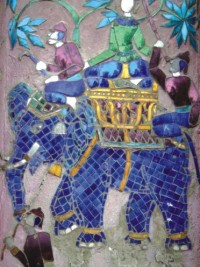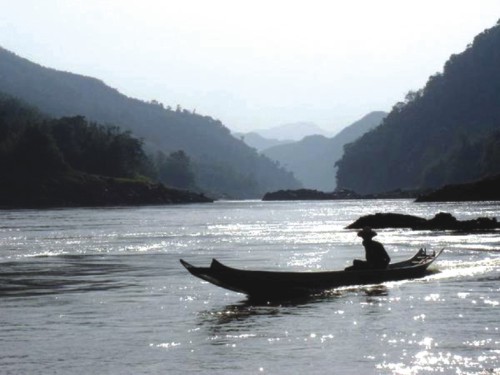|
Travel
Deep in Laos
Stephanie Brookes
Many travellers find this quaint, landlocked Southeast Asian country a tranquil and deeply spiritual place; a quiet backwater which provides travellers with a chance to slow down.
You can't get much slower than sitting. On my first day in Laos, I found myself sitting in an ancient Buddha cave. It was not something I often get the opportunity to do but, as a Westerner travelling to a place like Laos, it was just the sort of thing I could really enjoy -- removing me from of my own culture and allowing me to embrace the unfamiliar. As I cruised up the Mekong River, with dramatic limestone cliffs looming in the distance, the soft rhythmical putt-putt-putt of the long tail boat engine lulled me into a peaceful state.
Arriving at the Pak Ou Caves, however, was far from serene. As I negotiated my way across several boats tied together, I realised I would have to share the caves with around two hundred other tourists. That aside, it was fascinating to be in the presence of more than four thousand Buddha statues. The caves actually serve as a functioning temple; used for prayer and rituals by the local community on festive occasions.
A petite Lao woman at the cave entrance encouraged me to donate a few kip and draw from the Buddha sticks she had bunched together in a wooden container. She smiled, around her three front teeth, shook the container vigorously and I chose one at random. She checked my number and handed me a small piece of paper, written in Lao, and with a firm squeeze of my hands and a glint in her eye (no English spoken), I sensed I had drawn some good fortune.
Three hours easily drift by at the Buddha caves, and even though you have to share this place with other tourists, they come and go. You can spread out and enjoy the place at your leisure, and relax into the Laos tempo. In Asia they say, "the Vietnamese plant rice, the Cambodians watch it grow and the Laotians listen to it growing", and there is no better way to realise this truth than by spending a little while in the old city of Luang Prabang.
Luang Prabang is positioned at the confluence of the Mekong and Khan rivers. This Unesco World Heritage Listed ancient royal city sits ringed by mountains, coconut palms and dense jungle. The strict building codes have helped protect and preserve the flavour and charm of the historic town, which blends French colonial architecture, timeless timber shop-fronts, grand royal palaces and residences and 14th Century temples.

Luang Prabang, with an 11:30pm curfew, is free from advertising billboards and backpacker nightclubs. The old city is small and life moves at the pace of the local tuk-tuks and 50 cc motorbikes.
The best way to discover Luang Prabang is by walking the famous Royal Mile which links the palace with Wat Xieng Thong -- an impressive Buddhist complex of ornate temples decorated with intricate gold stencil work.
There are more than 30 temples to visit in and around the town. It was at Wat Choumkhong, a small but very pretty temple, where I had my conversation with a monk.
"Oh, I love being a monk", Sanoi said as he slowly and gracefully swept with a straw broom.
"I have been a monk for eight years and I am very happy. It provides me with the opportunity to study and learn English," he added.
Indeed, his English was near perfect.
"I am from a poor village and I feel privileged to be getting an education. I have a happy life."
As he delicately tended the poinsettia trees in this delightful little garden, I had to agree, he emitted a deep sense of contentment and happiness. Getting lost in the tiny laneways and crooked alleys of Luang Prabang brings surprises at every turn: Mottled sausages hanging on twine, cats snoozing in the sun and women squatting with stone bowls grinding fresh spices with mortar and pestle are just some of the enchanting sights.
It seems every second building is a guesthouse and, through the open windows of the quaint small wooden teak houses, you can get a glimpse of the charm and character within.
Sampling the fresh French-styled pastry goods in the cafes is sensational, and there are plenty of good coffee houses (serving the local brew).
It's pretty hard to go past the indulgence of a Lao or Khamu massage (for around US$5) or a herbal spa treatment. As you discover the delights of this charming town, the smell of mango, tamarind and lemongrass seem to flow in the gentle breeze that follows the Mekong. Or maybe it's just the spiritual energy that tails the wind in a place where two rivers meet.

The next morning I felt compelled to partake in one of Luang Prabang's living Buddhist traditions -- the morning alms giving.
At around 5:30am, I could hear the soft shuffling of slippered feet and smell the sweet aromatic warm sticky rice wafting through my window. It was a huge motivator to get up. In the early morning light, I knelt on my woven mat, kindly offered to me by a street vendor. After taking up my position next to local residents and other travellers, I mentally prepared myself for giving.
In the distance I could see a flow of saffron robes moving slowly toward me in silence. As each monk passed, I placed my offerings in their bowls. I alternated between rice, biscuits and mandarins, and followed the rhythm of this timeless ritual that seemed to honor the heart through the practical act of giving.
It is customary to show no emotion -- either donors or recipients. Eye contact is also not encouraged. The result of your actions is to feel boun (merit). It was a most humbling and memorable experience.
Laos is a comfortable, easy place to fit into. Life moves at a gentle pace and has a rhythm all of its own -- much like the Mekong River which flows through the country.
If you find you can slow down to match that pace, you may also find yourself listening to the rice grow.
This article was first published in The Jakarta Post. Courtesy: Asian News Network.
Copyright
(R) thedailystar.net 2008 |
